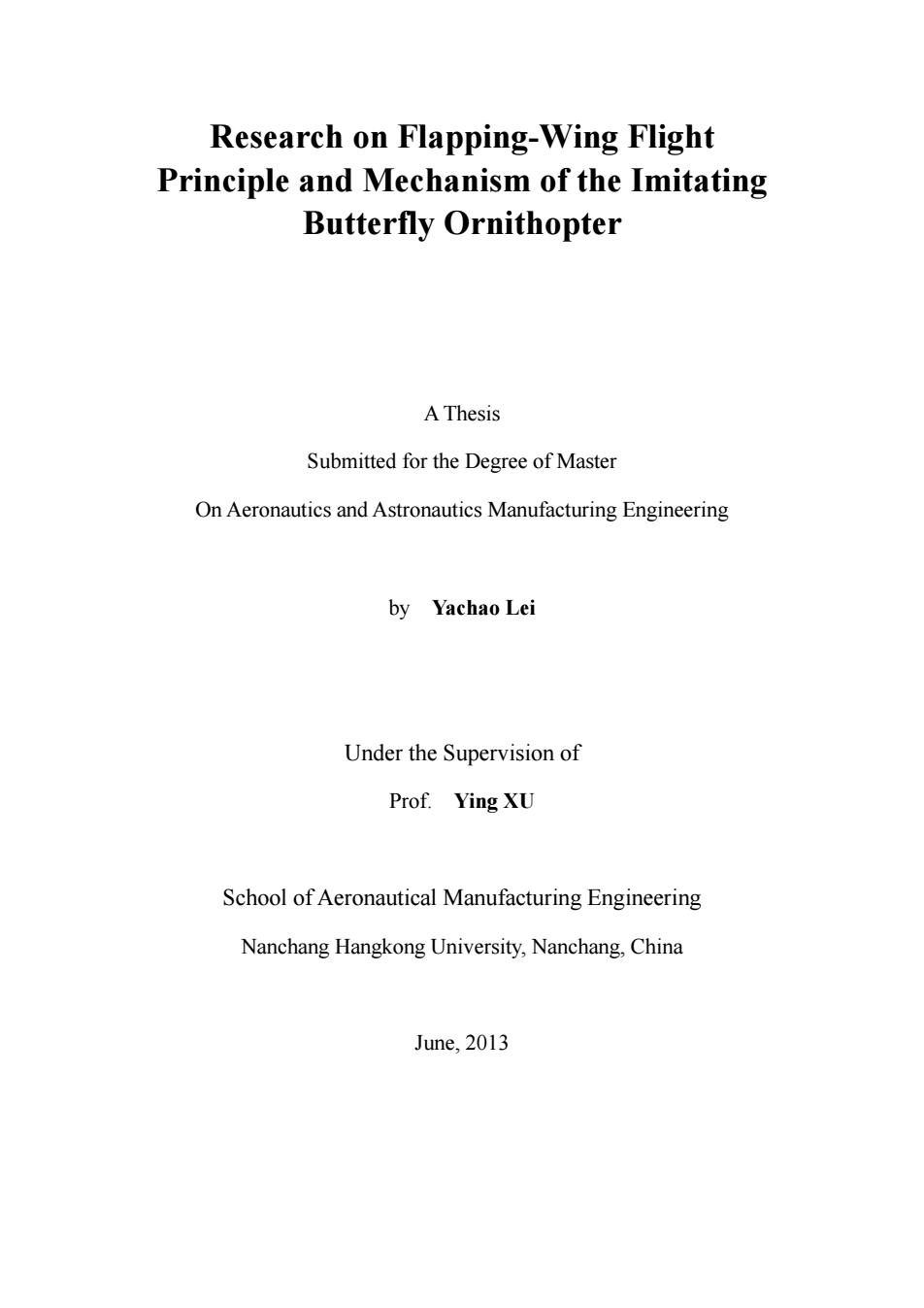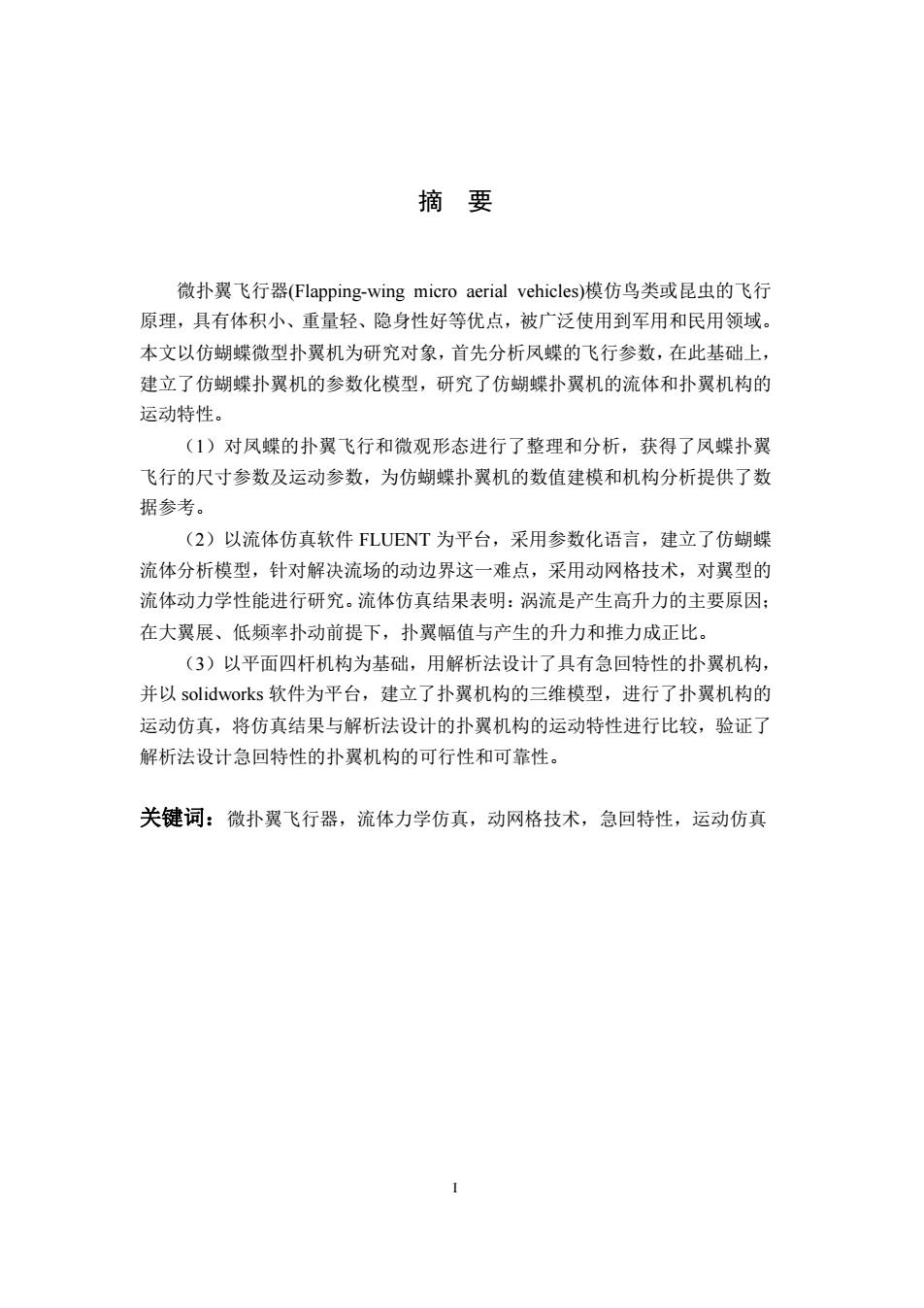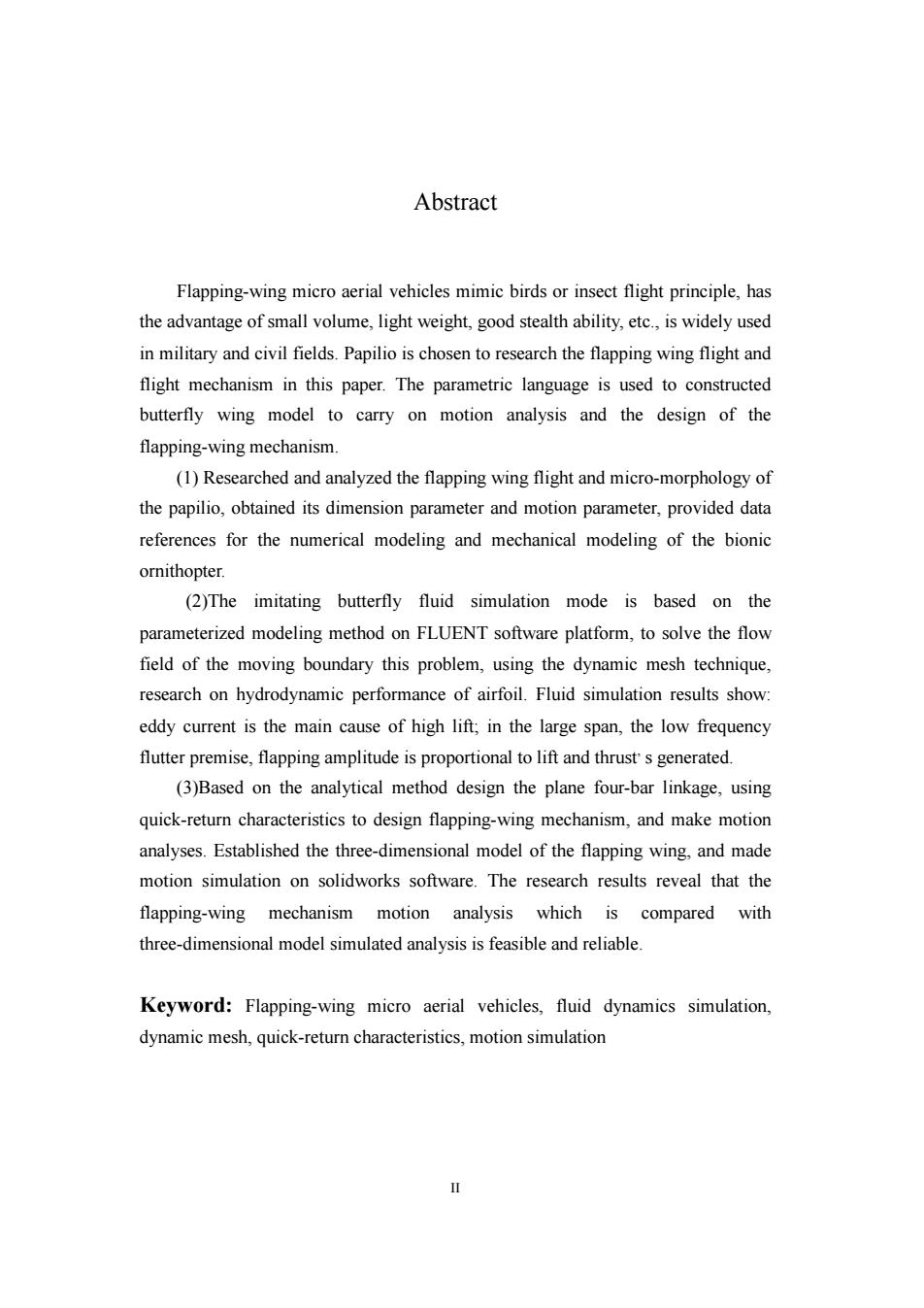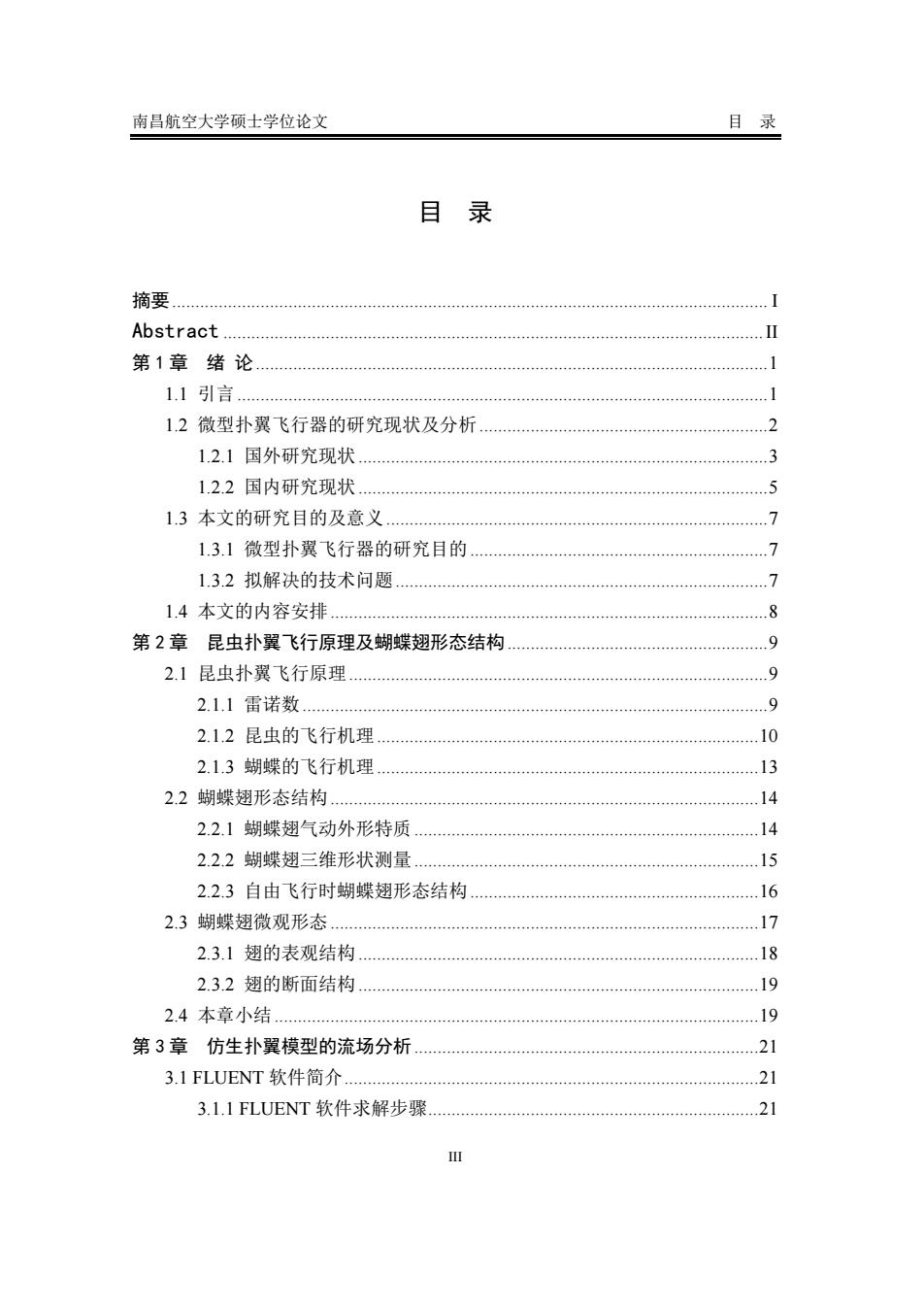
学校代码:10406 分类号:V276 学号:100082503015 南昌航空大学 硕士学位论文 (学位研究生) 仿蝴蝶微型扑翼机飞行原理及 扑翼机构研究 硕士研究生:雷亚超 导 师:许瑛教授 申请学位级别:硕士 学科、专业:航空宇航制造工程 所在单位:航空制造工程学院 答辩日期:2013年6月 授予学位单位:南昌航空大学
学校代码:10406 分类号:V276 学号:100082503015 南昌航空大学 硕 士 学 位 论 文 (学位研究生) 仿蝴蝶微型扑翼机飞行原理及 扑翼机构研究 硕 士 研 究 生 : 雷亚超 导 师 : 许 瑛 教授 申 请 学 位 级 别 : 硕 士 学 科 、 专 业 : 航空宇航制造工程 所 在 单 位 : 航空制造工程学院 答 辩 日 期 : 2013 年 6 月 授 予 学 位 单 位 : 南昌航空大学

Research on Flapping-Wing Flight Principle and Mechanism of the Imitating Butterfly Ornithopter A Thesis Submitted for the Degree of Master On Aeronautics and Astronautics Manufacturing Engineering by Yachao Lei Under the Supervision of Prof.Ying XU School of Aeronautical Manufacturing Engineering Nanchang Hangkong University,Nanchang,China June,2013
Research on Flapping-Wing Flight Principle and Mechanism of the Imitating Butterfly Ornithopter A Thesis Submitted for the Degree of Master On Aeronautics and Astronautics Manufacturing Engineering by Yachao Lei Under the Supervision of Prof. Ying XU School of Aeronautical Manufacturing Engineering Nanchang Hangkong University, Nanchang, China June, 2013

摘要 微扑翼飞行器(Flapping-wing micro aerial vehicles)模仿鸟类或昆虫的飞行 原理,具有体积小、重量轻、隐身性好等优点,被广泛使用到军用和民用领域。 本文以仿蝴蝶微型扑翼机为研究对象,首先分析凤蝶的飞行参数,在此基础上, 建立了仿蝴蝶扑翼机的参数化模型,研究了仿蝴蝶扑翼机的流体和扑翼机构的 运动特性。 (1)对凤蝶的扑翼飞行和微观形态进行了整理和分析,获得了凤蝶扑翼 飞行的尺寸参数及运动参数,为仿蝴蝶扑翼机的数值建模和机构分析提供了数 据参考。 (2)以流体仿真软件FLUENT为平台,采用参数化语言,建立了仿蝴蝶 流体分析模型,针对解决流场的动边界这一难点,采用动网格技术,对翼型的 流体动力学性能进行研究。流体仿真结果表明:涡流是产生高升力的主要原因: 在大翼展、低频率扑动前提下,扑翼幅值与产生的升力和推力成正比。 (3)以平面四杆机构为基础,用解析法设计了具有急回特性的扑翼机构, 并以solidworks软件为平台,建立了扑翼机构的三维模型,进行了扑翼机构的 运动仿真,将仿真结果与解析法设计的扑翼机构的运动特性进行比较,验证了 解析法设计急回特性的扑翼机构的可行性和可靠性。 关键词:微扑翼飞行器,流体力学仿真,动网格技术,急回特性,运动仿真
I 摘 要 微扑翼飞行器(Flapping-wing micro aerial vehicles)模仿鸟类或昆虫的飞行 原理,具有体积小、重量轻、隐身性好等优点,被广泛使用到军用和民用领域。 本文以仿蝴蝶微型扑翼机为研究对象,首先分析凤蝶的飞行参数,在此基础上, 建立了仿蝴蝶扑翼机的参数化模型,研究了仿蝴蝶扑翼机的流体和扑翼机构的 运动特性。 (1)对凤蝶的扑翼飞行和微观形态进行了整理和分析,获得了凤蝶扑翼 飞行的尺寸参数及运动参数,为仿蝴蝶扑翼机的数值建模和机构分析提供了数 据参考。 (2)以流体仿真软件 FLUENT 为平台,采用参数化语言,建立了仿蝴蝶 流体分析模型,针对解决流场的动边界这一难点,采用动网格技术,对翼型的 流体动力学性能进行研究。流体仿真结果表明:涡流是产生高升力的主要原因; 在大翼展、低频率扑动前提下,扑翼幅值与产生的升力和推力成正比。 (3)以平面四杆机构为基础,用解析法设计了具有急回特性的扑翼机构, 并以 solidworks 软件为平台,建立了扑翼机构的三维模型,进行了扑翼机构的 运动仿真,将仿真结果与解析法设计的扑翼机构的运动特性进行比较,验证了 解析法设计急回特性的扑翼机构的可行性和可靠性。 关键词:微扑翼飞行器,流体力学仿真,动网格技术,急回特性,运动仿真

Abstract Flapping-wing micro aerial vehicles mimic birds or insect flight principle,has the advantage of small volume,light weight,good stealth ability,etc.,is widely used in military and civil fields.Papilio is chosen to research the flapping wing flight and flight mechanism in this paper.The parametric language is used to constructed butterfly wing model to carry on motion analysis and the design of the flapping-wing mechanism. (1)Researched and analyzed the flapping wing flight and micro-morphology of the papilio,obtained its dimension parameter and motion parameter,provided data references for the numerical modeling and mechanical modeling of the bionic ornithopter. (2)The imitating butterfly fluid simulation mode is based on the parameterized modeling method on FLUENT software platform,to solve the flow field of the moving boundary this problem,using the dynamic mesh technique, research on hydrodynamic performance of airfoil.Fluid simulation results show: eddy current is the main cause of high lift;in the large span,the low frequency flutter premise,flapping amplitude is proportional to lift and thrust's generated. (3)Based on the analytical method design the plane four-bar linkage,using quick-return characteristics to design flapping-wing mechanism,and make motion analyses.Established the three-dimensional model of the flapping wing,and made motion simulation on solidworks software.The research results reveal that the flapping-wing mechanism motion analysis which is compared with three-dimensional model simulated analysis is feasible and reliable. Keyword:Flapping-wing micro aerial vehicles,fluid dynamics simulation, dynamic mesh,quick-return characteristics,motion simulation
II Abstract Flapping-wing micro aerial vehicles mimic birds or insect flight principle, has the advantage of small volume, light weight, good stealth ability, etc., is widely used in military and civil fields. Papilio is chosen to research the flapping wing flight and flight mechanism in this paper. The parametric language is used to constructed butterfly wing model to carry on motion analysis and the design of the flapping-wing mechanism. (1) Researched and analyzed the flapping wing flight and micro-morphology of the papilio, obtained its dimension parameter and motion parameter, provided data references for the numerical modeling and mechanical modeling of the bionic ornithopter. (2)The imitating butterfly fluid simulation mode is based on the parameterized modeling method on FLUENT software platform, to solve the flow field of the moving boundary this problem, using the dynamic mesh technique, research on hydrodynamic performance of airfoil. Fluid simulation results show: eddy current is the main cause of high lift; in the large span, the low frequency flutter premise, flapping amplitude is proportional to lift and thrust, s generated. (3)Based on the analytical method design the plane four-bar linkage, using quick-return characteristics to design flapping-wing mechanism, and make motion analyses. Established the three-dimensional model of the flapping wing, and made motion simulation on solidworks software. The research results reveal that the flapping-wing mechanism motion analysis which is compared with three-dimensional model simulated analysis is feasible and reliable. Keyword: Flapping-wing micro aerial vehicles, fluid dynamics simulation, dynamic mesh, quick-return characteristics, motion simulation

南昌航空大学硕士学位论文 目录 目录 摘要 Abstract 第1章绪论 1.1引言 …1 1.2微型扑翼飞行器的研究现状及分析 1.2.1国外研究现状 3 1.2.2国内研究现状 5 1.3本文的研究目的及意义 .7 1.3.1微型扑翼飞行器的研究目的 1.3.2拟解决的技术问题.… 7 1.4本文的内容安排… 8 第2章昆虫扑翼飞行原理及蝴蝶翅形态结构 9 2.1昆虫扑翼飞行原理 9 2.1.1雷诺数 9 2.1.2昆虫的飞行机理 .10 2.1.3蝴蝶的飞行机理 13 2.2蝴蝶翅形态结构… .14 2.2.1蝴蝶翅气动外形特质 女 2.2.2蝴蝶翅三维形状测量 15 2.2.3自由飞行时蝴蝶翅形态结构 16 2.3蝴蝶翅微观形态 17 2.3.1翅的表观结构 18 2.3.2翅的断面结构 19 2.4本章小结 19 第3章仿生扑翼模型的流场分析 21 3.1 FLUENT软件简介 .21 3.1.1 FLUENT软件求解步骤 .21
南昌航空大学硕士学位论文 目 录 III 目 录 摘要................................................................................................................................ I Abstract ....................................................................................................................II 第 1 章 绪 论..............................................................................................................1 1.1 引言..................................................................................................................1 1.2 微型扑翼飞行器的研究现状及分析..............................................................2 1.2.1 国外研究现状........................................................................................3 1.2.2 国内研究现状........................................................................................5 1.3 本文的研究目的及意义..................................................................................7 1.3.1 微型扑翼飞行器的研究目的................................................................7 1.3.2 拟解决的技术问题................................................................................7 1.4 本文的内容安排..............................................................................................8 第 2 章 昆虫扑翼飞行原理及蝴蝶翅形态结构........................................................9 2.1 昆虫扑翼飞行原理..........................................................................................9 2.1.1 雷诺数....................................................................................................9 2.1.2 昆虫的飞行机理..................................................................................10 2.1.3 蝴蝶的飞行机理..................................................................................13 2.2 蝴蝶翅形态结构............................................................................................14 2.2.1 蝴蝶翅气动外形特质..........................................................................14 2.2.2 蝴蝶翅三维形状测量..........................................................................15 2.2.3 自由飞行时蝴蝶翅形态结构..............................................................16 2.3 蝴蝶翅微观形态............................................................................................17 2.3.1 翅的表观结构......................................................................................18 2.3.2 翅的断面结构......................................................................................19 2.4 本章小结........................................................................................................19 第 3 章 仿生扑翼模型的流场分析..........................................................................21 3.1 FLUENT 软件简介.........................................................................................21 3.1.1 FLUENT 软件求解步骤.......................................................................21